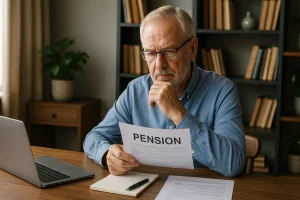Table of Contents
ToggleLet’s have a quick chat about something that’s been doing the rounds lately, maybe you’ve seen it on social media, in WhatsApp groups, or even overheard it at the post office.
There’s a rumour going around that anyone born before 25 September 1961 will automatically receive a £562 payment from the DWP this year. Some versions of the rumour even throw in a “$1,702 stimulus” and claim it’s already being sent out.
Sounds generous, right?
Especially in the current climate, where the cost of living is squeezing everyone, especially pensioners. But before you start planning how you’ll spend that money, it’s important to take a step back.
Because here’s the truth: there is no official DWP scheme offering a £562 one-off payment specifically for people born before 1961. None. The UK Government has not announced any such payment, and if you check GOV.UK, there is no mention of it either.
So where has this claim come from? And more importantly, what support is actually available for pensioners? Let’s unpack it.
Is There a £562 DWP Payment for Pensioners Born Before 1961?

The short answer? No, there isn’t.
This rumour seems to have started online and picked up speed quickly, most likely fuelled by a mixture of genuine confusion and wishful thinking. Over the last few years, the government has issued cost of living payments and energy support schemes.
These payments ranged from £150 to £300, depending on age and income, and many were added automatically to pensions during the winter months. That’s likely where the £562 figure came from, a combination of multiple payments added together in previous years.
However, as of now, there is no specific £562 payment for pensioners born before 25 September 1961. The DWP hasn’t made any such announcement, and no reliable government website supports the claim.
That’s not to say pensioners aren’t entitled to help, they absolutely are, but it’s important to separate fact from fiction. And while we’re on the topic, there’s another area that often causes confusion: the Additional State Pension.
What Exactly Is the Additional State Pension?
Now this is a benefit that actually does exist, but it’s not new, and it’s definitely not a one-off lump sum.
The Additional State Pension is an extra amount that some people receive on top of their Basic State Pension. But it’s only available to a very specific group: men born before 6 April 1951 and women born before 6 April 1953.
If you were born after those dates, you fall under the New State Pension system introduced in 2016, which doesn’t include the Additional State Pension.
So, what is it? It’s a top-up based on your National Insurance contributions, your earnings, and whether you were ever contracted out of the system. You don’t apply for it,it’s calculated and added automatically if you’re eligible when you claim your State Pension.
It’s not a standard payment either. Some people might get a small amount, others much more. It all depends on your work history.
How Do You Qualify for the Additional State Pension?
Eligibility is fairly strict. You could receive the Additional State Pension if:
- You were born before 6 April 1951 (men) or before 6 April 1953 (women)
- You reached State Pension age before 6 April 2016
- You made enough qualifying National Insurance contributions
- You weren’t contracted out through your job or employer’s pension scheme
If you reached State Pension age on or after 6 April 2016, you’ll receive the New State Pension, and the Additional State Pension won’t apply to you, though you may be eligible to inherit some of it from a spouse or civil partner in some cases.
Let’s break this down with an example:
Example:
Joan was born in 1950 and retired in 2015. She worked for 30 years and paid full National Insurance contributions during that time. Because she wasn’t contracted out, she qualifies for the Basic State Pension and an Additional State Pension of about £50 a week, based on her earnings record.
How Is the Additional State Pension Calculated?

This is where it gets a bit technical. There’s no set amount that everyone gets.
The DWP calculates the Additional State Pension based on a few things:
- Your earnings between 1978 and 2016
- Your National Insurance record
- Whether you were contracted out at any point
- Whether you opted to top up your pension between 2015 and 2017
Between 1978 and 2002, the scheme was called SERPS (State Earnings-Related Pension Scheme). From 2002 onwards, it became the State Second Pension. These are essentially the same idea, earning-related top-ups, but structured differently.
There was also a short window between October 2015 and April 2017 where you could voluntarily top up your State Pension, but that scheme has now closed.
How Much Can You Actually Get from It?
The maximum Additional State Pension currently sits at £222.10 per week (as of 2025), but very few people receive the full amount. Most people receive something significantly less, depending on their circumstances.
Here’s a general idea:
| Profile | Contribution History | Weekly Additional Pension |
| David, born 1950 | Full-time, not contracted out | £200 |
| Jean, born 1952 | Worked part-time, some years contracted out | £110 |
| Trevor, born 1951 | Contracted out most of career | £35 |
The key takeaway here is: the payment isn’t fixed and certainly isn’t issued as a single lump sum like the £562 rumour suggests.
What If You Were Contracted Out?

Many people, especially those in public sector jobs, were contracted out of the Additional State Pension through their employer. This means they paid lower National Insurance contributions in exchange for building up a separate workplace or private pension.
If that was the case for you, your Additional State Pension amount will be reduced, sometimes to zero.
Example:
Alan worked for the council for 25 years. His pension scheme was contracted out, so he paid reduced NI. As a result, his Additional State Pension is minimal, just £15 a week.
Can You Inherit Additional State Pension from a Spouse?
Yes, but again, it depends on your specific circumstances. If your spouse or civil partner has died, you may be able to inherit part of their Additional State Pension, but the rules are complicated.
If your partner died before 6 October 2002, you could inherit up to 100% of their Additional State Pension. After that, the percentage gradually reduces based on their date of birth.
Here’s how the inheritance typically works:
| Spouse’s DOB | Maximum Inheritance |
| Before 6 Oct 1937 (men) / 6 Oct 1942 (women) | 100% |
| 6 Oct 1943 – 5 Oct 1945 / 6 Oct 1948 – 5 Jul 1950 | 60% |
| 6 Oct 1945 or later / 6 Jul 1950 or later | 50% |
There are also restrictions: if you remarry or enter into a new civil partnership before reaching State Pension age, you may lose your right to inherit it.
Why Does This Rumour Keep Spreading?
Simply put, people are desperate for financial help, and rightfully so. Inflation, energy bills, food costs… they’re all rising. So when a rumour like this starts, people share it quickly, hoping it’s true.
Add to that the fact that the government has issued one-off payments in the past (such as Cost of Living Payments or Cold Weather Payments), and it’s easy to see how confusion builds.
But to be clear: there is no £562 automatic DWP payment for pensioners born before 1961. The DWP has made no announcement, and no credible news source or government site confirms it.
What Should Pensioners Do Instead?
If you’re wondering what you’re actually entitled to, here’s the best advice:
- Check your State Pension forecast on GOV.UK
- Contact the Pension Service if you think your payments are incorrect
- Avoid unofficial websites or social media “announcements”
- Visit trusted resources like GOV.UK, Age UK, or Citizens Advice for guidance
And if you’re ever unsure, speak to someone, whether it’s a financial adviser, a local support service, or the DWP directly.
FAQs
Is the £562 DWP payment for pensioners real?
No, this is a rumour. The DWP has not confirmed any such payment.
Who qualifies for the Additional State Pension?
Only men born before 6 April 1951 and women born before 6 April 1953 who reached State Pension age before 6 April 2016.
Is the Additional State Pension paid separately?
No, it’s included automatically with your Basic State Pension if you’re eligible.
What if I was contracted out?
You may receive a reduced Additional State Pension, or none at all.
Can I inherit Additional State Pension?
Yes, depending on your spouse’s age and date of death, you may inherit part of it.
Can people born after 1961 get the Additional State Pension?
No, they fall under the New State Pension system, which does not include Additional State Pension.
How much is the Additional State Pension?
It varies. The maximum is £222.10 per week, but most receive less based on earnings and contributions.




